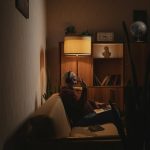The one lighting hack to instantly boost your on-camera presence is to use soft, diffused light. Position yourself near a window during the golden hour or invest in LED lights and softboxes for even illumination. Aim to place your key light at a 45-degree angle to avoid harsh shadows that can flatten your features. A little experiment with angles can work wonders for your look and engagement. Stick around to uncover more tips for a polished appearance!
Table of Contents
Key Takeaways
- Position your key light at a 45-degree angle to your face for a naturally flattering illumination that enhances features.
- Use soft, diffused lighting, such as softboxes or ring lights, to minimize shadows and create a more engaging visual.
- Take advantage of natural light during golden hours for warm, inviting tones that elevate your on-camera presence.
- Avoid harsh overhead lighting to prevent unflattering shadows; instead, opt for side lighting to add depth and dimension.
- Experiment with light angles and distances to find the most flattering setup that enhances your unique personality on camera.
Understanding the Importance of Lighting
When you step in front of the camera, the right lighting can make all the difference in how you come across. It sets the mood, highlights your features, and draws attention to your expressions.
Poor lighting can leave you looking flat or uninviting, while good lighting enhances your presence and engagement. Natural light is often a favorite, but you can achieve great results with artificial sources, too.
Positioning lights at the right angles can minimize shadows and create a more dynamic look. Experiment with different setups to find what works best for you.
The Key to Natural Illumination
To achieve the most flattering natural illumination, you need to contemplate the time of day and your surroundings. Early morning or late afternoon provides soft, golden light that enhances your features without harsh shadows.
Position yourself near windows to harness that natural glow; it’s the best filter available. Pay attention to the weather, too; overcast days yield diffused light, perfect for minimizing glare.
Position yourself by windows for the best natural glow, and embrace overcast days for beautifully diffused light.
Avoid direct sunlight, as it can create unflattering contrasts. Instead, look for shaded areas outdoors or utilize indoor spaces with ample natural light.
Experiment with angles to find your best side, and remember to keep the light in front of you, illuminating your face and drawing attention to your expressions. This simple approach can dramatically elevate your on-camera presence.
Choosing the Right Light Source
How do you choose the right light source for your on-camera presence? Selecting the perfect light can elevate your appearance and enhance your message. Here are some key factors to evaluate:
- LED Lights: Energy-efficient and versatile, great for all setups.
- Softboxes: Provide diffused, even lighting that reduces harsh shadows.
- Ring Lights: Create flattering, uniform illumination, ideal for close-ups.
- Natural Light: Free and often the most flattering, but unpredictable.
- Key Light vs. Fill Light: Understand the difference to achieve balanced lighting.
Positioning Your Lights for Maximum Effect
Selecting the right light source is just the first step; getting the positioning right can make all the difference in your on-camera presence.
Position your key light at a 45-degree angle to your face. This angle creates soft shadows, enhancing your features and adding depth. Avoid placing it directly in front of you, as that can flatten your appearance.
Next, use a fill light on the opposite side to soften any harsh shadows. Keep this light dimmer than your key light for balance.
Finally, consider a backlight to separate you from the background, adding a professional touch. Experiment with angles and distances to find what works best for you.
Good positioning is key to engaging your audience!
Avoiding Common Lighting Mistakes
When you’re setting up your lights, the direction can make or break your on-camera presence.
Don’t forget about color temperature balance; mismatched lighting can create an unflattering look.
Let’s explore how to steer clear of these common pitfalls for better results.
Direction of Light
Although it might seem trivial, the direction of light can make or break your on-camera presence. Properly positioning your light source is crucial for showcasing your best features and avoiding unflattering shadows.
Here are some common mistakes you should avoid:
- Front lighting can flatten your features; try soft angles instead.
- Overhead lighting can create harsh shadows under your eyes and chin.
- Side lighting can add depth but may also produce unflattering contrasts.
- Backlighting without fill can leave you in silhouette, losing your visibility.
- Inconsistent lighting can confuse viewers and distract from your message.
Color Temperature Balance
Lighting isn’t just about direction; color temperature balance plays a significant role in your on-camera presence.
If you’ve ever looked at your footage and felt something was off, it might be due to mismatched color temperatures. Mixing warm and cool lights can create unflattering skin tones and distract viewers.
Stick to one color temperature to maintain consistency. For instance, if you’re using daylight bulbs, avoid adding warmer incandescent lights. A balanced setup will enhance your appearance and keep your audience focused on your message.
Don’t forget to adjust white balance settings on your camera to match your lighting. By ensuring color temperature harmony, you’ll instantly elevate your on-camera presence and appear more professional.
Enhancing Your Background With Lighting
To make your background pop, you’ll want to focus on specific lighting techniques.
Consider the color temperature of your lights to create a cohesive look, and be mindful of how shadows can affect the overall scene.
With the right approach, you can enhance your on-camera presence markedly.
Background Lighting Techniques
While you focus on your on-camera presence, enhancing your background with effective lighting can greatly elevate your overall look.
Proper background lighting techniques can add depth and interest to your shot, making you stand out. Here are some tips to ponder:
- Use soft, diffused lights to minimize harsh shadows.
- Position a light source behind you to create a subtle halo effect.
- Incorporate colored lights to add personality and mood.
- Use practical lights like lamps or fairy lights to create warmth.
- Experiment with light intensity to find the perfect balance.
Color Temperature Considerations
Enhancing your background lighting not only involves placement and intensity but also requires attention to color temperature. The right color temperature can set the mood and enhance your on-camera presence. Aim for a color temperature that complements your skin tone—typically between 3200K to 5600K.
Warmer tones (around 3200K) create a cozy, inviting atmosphere, while cooler tones (around 5600K) convey a more professional, crisp look.
Consider the existing light sources in your environment. If your background has warm lights, balance them with warmer lighting on yourself. If it’s cooler, adjust accordingly.
This harmony not only improves the aesthetic but also keeps the focus on you, making your presentation more engaging and visually appealing.
Avoiding Shadows Effectively
Shadows can be a major distraction during your on-camera presentations, but you can effectively minimize them with strategic lighting.
Here are some tips to enhance your background and keep shadows at bay:
- Use Diffused Lighting: Soft, diffused light reduces harsh shadows.
- Position Your Lights: Place lights at 45-degree angles for even illumination.
- Light the Background: Add background lights to separate yourself from the backdrop.
- Choose the Right Color: Light colors reflect better, helping to brighten the scene.
- Avoid Overhead Lighting: This can cast unflattering shadows on your face.
Experimenting With Different Lighting Techniques
How can you elevate your on-camera presence with the right lighting techniques? Start by experimenting with different sources and angles of light.
Try soft lighting for a more flattering look, which reduces harsh shadows on your face. Positioning your light source at a 45-degree angle can create depth and dimension.
You might also consider backlighting to create a halo effect, adding interest to your background. Don’t forget about colored gels; they can dramatically change the mood of your scene.
Test out various setups and see how they affect your appearance on camera. Finally, always check your results on-screen to find the best combination that enhances your unique features and brings your personality to life.
Final Tips for Polishing Your On-Camera Look
There’s something about a polished on-camera look that can make all the difference in how your message is received.
To truly stand out, consider these final tips to enhance your presence:
- Choose the right outfit: Solid colors often work best; avoid busy patterns.
- Mind your background: A clean, uncluttered backdrop keeps the focus on you.
- Use minimal accessories: Keep jewelry simple to avoid distractions.
- Practice good posture: Sit or stand tall to convey confidence.
- Maintain eye contact: Look at the camera as if you’re speaking to a friend.
Frequently Asked Questions
What Type of Light Bulb Is Best for Video Recording?
For video recording, you’ll want LED bulbs. They provide consistent lighting, reduce flicker, and offer adjustable color temperatures. Using daylight-balanced bulbs helps create a natural look, enhancing your overall video quality and presence.
How Does Skin Tone Affect Lighting Choices?
Skin tone considerably affects your lighting choices. For lighter skin, softer, cooler lights work best, while darker skin benefits from warmer, more intense lighting. Adjusting your light’s color temperature can enhance your on-camera appearance dramatically.
Can I Use Natural Light for Indoor Filming?
Yes, you can definitely use natural light for indoor filming. Position yourself near windows to take advantage of soft, flattering light. Just avoid harsh midday sun to prevent unflattering shadows on your face.
What Time of Day Is Best for Natural Lighting?
The best time for natural lighting is during the golden hour—shortly after sunrise or before sunset. You’ll get soft, warm light, enhancing your visuals and creating a flattering atmosphere for your indoor filming.
How Do I Avoid Glare From Glasses on Camera?
Isn’t it frustrating when glare ruins your shot? To avoid it, tilt your head slightly or adjust your camera angle. You can also use anti-reflective lenses, ensuring your on-camera presence shines without distractions.




